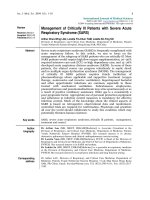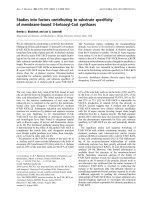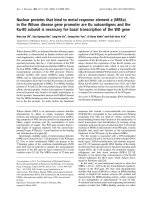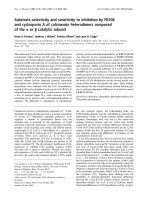Báo cáo y học: "Infective endocarditis: too ill to be operated" doc
Bạn đang xem bản rút gọn của tài liệu. Xem và tải ngay bản đầy đủ của tài liệu tại đây (32.12 KB, 3 trang )
CNS = central nervous system; ICU = intensive care unit; IE = infective endocarditis.
Critical Care April 2002 Vol 6 No 2 Rubinovitch and Pittet
Infective endocarditis (IE) has remained a prevalent disease
in general hospitals, with a fairly constant incidence over the
past 30 years, accounting for one case per 1000 hospital
admissions (range 0.38–1.24 per 1000 admissions) [1].
Despite modern antibiotic and surgical therapy, mortality
rates remain as high as 25% for both native- and prosthetic-
valve endocarditis, with death resulting primarily from central
nervous system (CNS) embolic events and hemodynamic
deterioration [2].
Surgical management
Valve replacement has become an important adjunct to
medical therapy in the management of this complex infection
that is difficult to treat, and a surgical approach may be
required, although the infecting organisms are often
exquisitely sensitive to antibiotics in vitro. Surgery is now used
in at least 25% of cases and several studies suggest that
combined medical and surgical therapy can reduce both early
and late mortality in patients with a complicated course [2,3].
There are several consensus indications for surgery during
active IE: refractory congestive heart failure and
physiologically significant valve dysfunction demonstrated by
echocardiography; uncontrolled infection; ineffective
antimicrobial therapy and perivalvular extension of infection;
most cases of prosthetic valve endocarditis; and resection of
mycotic aneurysm [1]. Arguable indications are the presence
of more than one serious systemic embolic episode or one
embolus with large residual vegetation [4].
Congestive heart failure has remained the strongest
indication for surgery in IE. For example, medically-treated
patients with moderate-to-severe heart failure due to
endocarditis-related valvular dysfunction have a mortality rate
of 56–86 %, as compared with 11–35% among patients
treated with combined medical and surgical therapy [5–7].
The beneficial effect of surgery persists even in the presence
of comorbidities; therefore the occurrence of other
complications of IE, such as acute renal failure, is not a
contraindication for valve replacement.
Cerebral complications
There is a significant risk for postoperative neurologic
deterioration or death in patients with a recent CNS
Commentary
Infective endocarditis: too ill to be operated?
Bina Rubinovitch* and Didier Pittet
†
*Research Associate, Infection Control Program, Department of Internal Medicine, University of Geneva Hospitals, Switzerland
†
Director of Infection Control Program, Department of Internal Medicine, University of Geneva Hospitals, Switzerland
Correspondence: Didier Pittet,
Published online: 12 March 2002 Critical Care 2002, 6:106-107
© 2002 BioMed Central Ltd (Print ISSN 1364-8535; Online ISSN 1466-609X)
Abstract
Infective endocarditis remains a disease associated with high mortality in certain groups of patients,
with death resulting primarily from central nervous system complications and congestive heart failure.
Combined medical and surgical therapy reduces both early and late mortality in complicated cases,
especially in patients with valvular dysfunction related to heart failure. In these patients, heart failure is
the strongest indication for valve replacement. There are no consensus indications for surgery,
however, in the presence of neurological complications or multiple organ failure. Limited data suggest
that such surgery is feasible, even in complicated cases necessitating admission to the intensive care
unit, and carries an acceptable risk for in-hospital mortality. It is important that critically ill patients with
infective endocarditis are enrolled into multicenter studies, using adequate severity scoring systems to
assess the impact of clinical and imaging variables on patients’ outcome. Until such data are obtained,
clinical judgement is still the best tool in decision-making regarding the individual patient.
Keywords decision-making, infective endocarditis, neurological complications, valve replacement
Available online />complication of IE, therefore such an event is considered a
relative contraindication for early cardiac surgery [2].
Since neurologic complications of IE are frequent (20–40%
of patients) and their presence can increase the mortality rate
up to 58% [1], what can be considered as the appropriate
management of a patient with IE complicated by both
hemodynamic deterioration and a new onset embolic stroke?
Unfortunately, there are currently no satisfactory studies to
assist in decision analysis for such a dilemma.
In a retrospective study from Japan [8], 181 patients with
cerebral complications were identified among 2523 cases
that underwent surgery for IE. Overall mortality in patients with
and without CNS complications was similar. Among patients
with cerebral infarcts, mortality was related to the interval
between the preceding cerebral event and surgery. Death
occurred in 66% of patients operated within 24 hours of the
event, in 48% of those operated less than a week after
cerebral infarction, but in only 19% operated 7–28 days
postinfarction. In a multivariate analysis, however, the only risk
factor for worsening neurological outcome was the severity of
neurological complication. Other studies have reported
contradictory results regarding the impact of neurological
complications on surgical outcome in patients submitted for
valve replacement in the course of active IE [9–11].
Critical analysis of these studies is difficult. Some of these
retrospective cohorts consist of surgical patients only (i.e.
patients considered too ill to be operated have already been
excluded). In other studies, medically-treated patients are
compared with those submitted to surgery, but the reasons
for choosing one therapeutic approach over another are not
well specified. Therefore, the differences in outcome can be
attributed to many factors such as the patient’s general,
neurological condition, and the various indications for valve
replacement.
ICU admission
In this issue of Critical Care, Georg Delle Karth and his
colleagues [12] describe their experience with a cohort of
patients with IE necessitating admittance to the intensive
care unit (ICU). These patients represented 0.8% of ICU
admissions, which is 10-fold the incidence of IE among all
hospital admissions, reflecting the life-threatening potential of
this infection. Not surprisingly, 90% of indications for ICU
admittance were congestive heart failure, septic shock, and
neurological complication — also major risk factors for poor
outcome. Among patients treated with combined medical
and surgical therapy, mortality was 35%, but increased 2.4-
fold (84%) among medically-treated patients.
Lessons to be learned
What can we learn from these data? Since this study was
not designed to evaluate risk factors for mortality, we cannot
conclude that surgery decreases mortality in critically-ill
patients with complicated IE. As in other similar series, the
surgical intervention was based on clinical judgement and
not on strict predetermined criteria. For instance, 5/13
medically-treated patients were deferred from surgery due to
a doubtful neurological outcome or severe comorbidities. An
additional 6/13 died before surgery could be performed.
Consequently, the medically-treated group consisted of only
two patients in whom surgery was deemed to be not
indicated — both survived! These data do not provide
meaningful evidence regarding medically-treated patients
with complicated IE. Most importantly, the results of this
study suggest that even in critically ill patients with
complicated IE, prompt valve replacement may be life-saving,
carrying an acceptable risk for mortality, comparable to the
rate of in-hospital mortality in patients with severe sepsis.
Decision-making
Can we improve our decision process regarding early
surgery in critically ill patients with IE in view of the current
data? The only way to obtain meaningful data regarding this
issue would be through well-designed prospective studies,
using adequate severity scoring systems to assess the
impact of clinical and imaging variables on patients’ outcome.
It is important that critically ill patients with IE are enrolled
into multicenter studies addressing these questions. Until
such data are obtained, clinical judgement is still the best
tool in making decisions regarding the individual patient. Data
from studies such as the one by Delle Karth et al. [12],
though not perfect, provide valuable information regarding
the feasibility and outcomes of various approaches in
different clinical situations, and contribute to making the
‘intuitive’ decision-making process somewhat better.
Competing interests
None declared.
References
1. Franciolli PB: Complications of infective endocarditis. In Infec-
tions of the Central Nervous System. Edited by Scheld WM,
Whitley RJ, Durak DT. Philadelphia: Lippincott-Raven; 1997:523-
553.
2. Mylonakis E, Calderwood SB: Infective endocarditis in adults.
N Engl J Med 2001, 345:1318-1330.
3. Bayer AS, Scheld WA: Endocarditis and intravascular infec-
tions. In Mandell, Douglas and Bennett’s Principles and Practice
of Infectious Diseases. Edited by Mandell GA, Bennett JE, Dolin
R. Philadelphia: Churchill Livingstone; 2000:857-902.
4. Bayer AS, Bolger AF, Taubert KA, Wilson W, Steckelberg J,
Karchmer AW, Levison M, Chambers HF, Dajani AS, Gewitz MH,
Newberger JW, Gerber MA, Shulman ST, Pallash T, Gage TW,
Ferrieri P: Diagnosis and management of infective endocardi-
tis and its complications. Circulation 1998, 98:2936-2948.
5. Griffin FM Jr, Jones G, Cobbs CC: Aortic insufficiency in bacte-
rial endocarditis. Ann Intern Med 1972, 76:23-28.
6. Richardson JV, Karp RB, Kirklin JW, Dismukes WE: Treatment of
infective endocarditis: a 10-year comparative analysis. Circu-
lation 1978, 58:589-597.
7. Croft CH, Woodward W, Elliott A, Commerford PJ, Barnard CN,
Beck W: Analysis of surgical versus medical therapy in active
complicated native valve infective endocarditis. Am J Cardiol
1983, 51:1650-1655.
8. Eishi K, Kawazoe K, Kuriyama Y, Kitoh Y, Kawashima Y, Omae T:
Surgical management of infective endocarditis associated
Critical Care April 2002 Vol 6 No 2 Rubinovitch and Pittet
with cerebral complications: multi-center retrospective study
in Japan. J Thorac Cardiovasc Surg 1995, 110:1745-1755.
9. Ting W, Silverman N, Levitsky S: Valve replacement in patients
with endocarditis and cerebral septic emboli. Ann Thorac Surg
1991, 51:18-21.
10. Parrino PE, Kron IL, Ross SD, Shockey KS, Kron AM, Towler MA,
Tribble CG: Does a focal neurologic deficit contraindicate
operation in a patient with endocarditis? Ann Thorac Surg
1999, 67:59-64.
11. Heiro M, Nikoskelainen J, Engblom E, Kotilainen E, Marttila R,
Kotilainen P: Neurologic manifestations of infective endocardi-
tis: a 17-year experience in a teaching hospital in Finland.
Arch Intern Med 2000,160:2781-2787.
12. Delle Karth G, Koreny M, Binder T, Knapp S, Zauner C, Valentin
A, Honninger R, Heinz G, Siostrzonek P: Complicated infective
endocarditis necessitating ICU admission: clinical course and
prognosis. Critical Care 2002, 6:149-154.









